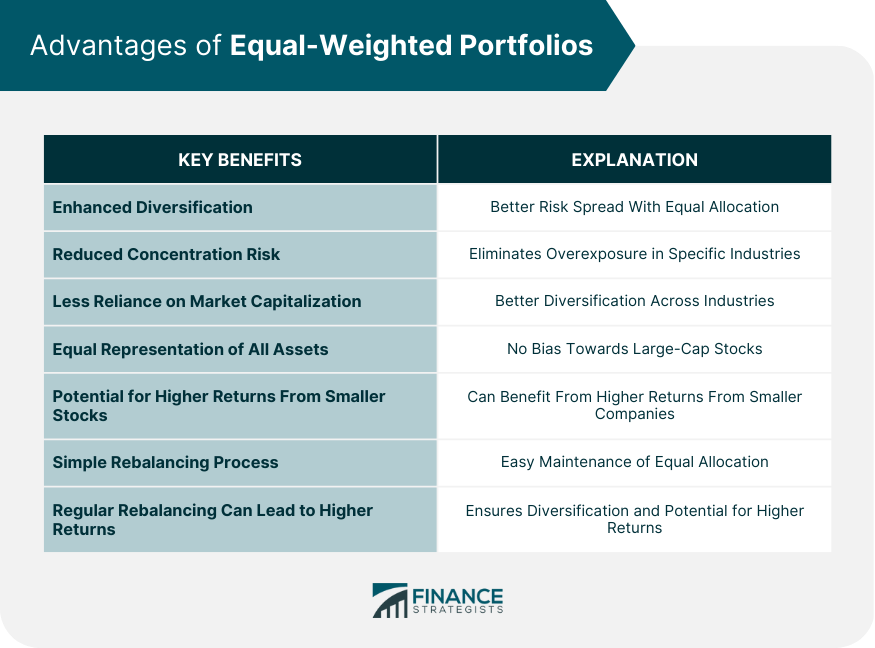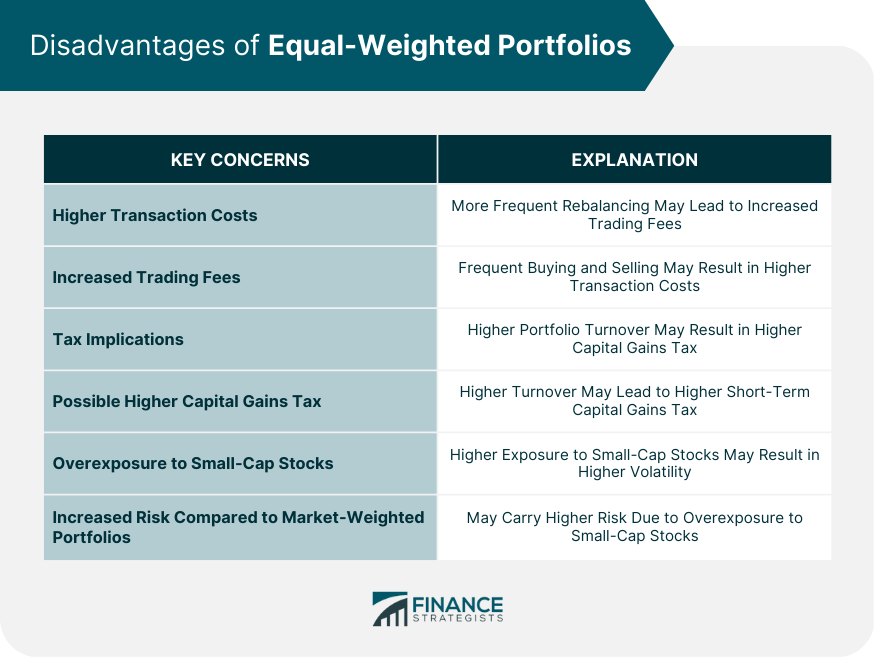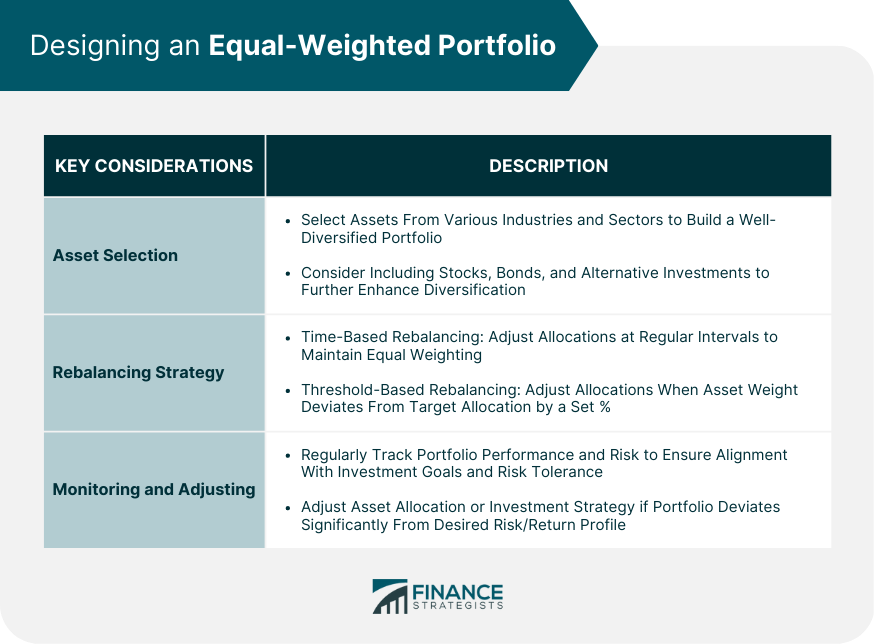An equal-weighted portfolio is an investment strategy in which all assets are allocated an equal proportion of the total investment. This approach ensures that each asset has the same influence on the overall performance of the portfolio, regardless of its market capitalization or other factors. For example, in an equal-weighted portfolio of 10 stocks, each stock would be allocated 10% of the portfolio's total value. If the portfolio were rebalanced periodically, the allocation to each stock would be adjusted back to 10% to maintain equal weighting. Market-weighted portfolios, on the other hand, allocate assets based on their market capitalization. In this method, larger companies have a more significant impact on the portfolio's performance. This can lead to a concentration of risk in a few large-cap stocks, whereas equal-weighted portfolios offer better diversification. Diversification is a key principle in investment, as it helps spread risk across various assets. By allocating equal weight to each asset, investors can reduce the impact of any single stock on the overall portfolio, potentially improving risk management. Equal-weighted portfolios reduce the concentration risk that may arise from holding a few large-cap stocks. By allocating equal portions to each asset, investors can better spread risk and potentially achieve more stable returns. Market-weighted portfolios tend to favor large-cap stocks, which can lead to overexposure in certain industries or sectors. Equal-weighted portfolios, on the other hand, do not rely on market capitalization and offer better diversification across industries and sectors. Equal-weighted portfolios treat all assets equally, ensuring that each stock has the same impact on the portfolio's performance. This approach eliminates the bias towards large-cap stocks often seen in market-weighted portfolios. By giving equal weight to smaller stocks, equal-weighted portfolios can potentially benefit from higher returns generated by these companies. This may lead to higher overall portfolio returns compared to market-weighted portfolios. Rebalancing an equal-weighted portfolio is a straightforward process, as it simply involves maintaining equal allocations across all assets. This can be done periodically or when specific thresholds are reached. Rebalancing ensures that the portfolio remains diversified and may result in higher returns due to the potential outperformance of smaller stocks. Equal-weighted portfolios typically require more frequent rebalancing compared to market-weighted portfolios. This can lead to higher transaction costs due to increased trading fees. The need to buy and sell assets more frequently when rebalancing an equal-weighted portfolio can result in higher trading fees, which may eat into potential returns. Frequent rebalancing can result in higher portfolio turnover, which may have tax implications for investors. This is especially true for taxable accounts, where capital gains taxes may apply. Higher turnover can lead to higher short-term capital gains, which are typically taxed at a higher rate than long-term capital gains. This may negatively impact the overall returns of the portfolio. Equal-weighted portfolios may have higher exposure to small-cap stocks, which can be more volatile than large-cap stocks. This increased volatility can result in higher risk for the investor. While equal-weighted portfolios offer better diversification, they may still carry higher risk compared to market-weighted portfolios due to the overexposure to small-cap stocks. Investors should carefully consider their risk tolerance before choosing an equal-weighted investment strategy. To build a well-diversified equal-weighted portfolio, investors should select assets from various industries and sectors. This helps to spread risk and reduce the impact of any single industry or sector on the portfolio's overall performance. In addition to diversifying across industries and sectors, investors should consider including various asset classes, such as stocks, bonds, and alternative investments, to further enhance the portfolio's diversification. Time-based rebalancing involves adjusting the portfolio's allocations at regular intervals, such as quarterly or annually. This ensures that the equal weighting is maintained over time, regardless of the assets' performance. Threshold-based rebalancing involves adjusting the portfolio's allocations when the weight of any asset deviates from the target allocation by a predetermined percentage. This approach can help maintain the equal weighting while also potentially reducing the need for frequent rebalancing. Investors should regularly monitor the performance and risk of their equal-weighted portfolio to ensure it remains aligned with their investment goals and risk tolerance. If the portfolio's risk or performance deviates significantly from the investor's objectives, adjustments should be made to the asset allocation or investment strategy to bring the portfolio back in line with the desired risk and return profile. Historically, equal-weighted portfolios have shown mixed results when compared to market-weighted portfolios. In some periods, equal-weighted portfolios have outperformed their market-weighted counterparts, while in other periods, they have underperformed. Equal-weighted portfolios have been observed to outperform market-weighted portfolios during periods of market recovery. This is because smaller stocks, which are given equal weight in the portfolio, tend to recover more quickly than large-cap stocks. Conversely, equal-weighted portfolios may underperform during market downturns, as the higher exposure to small-cap stocks can lead to increased volatility and risk. When comparing the risk-adjusted returns of equal-weighted and market-weighted portfolios, the Sharpe ratio can be a useful metric. In some cases, equal-weighted portfolios may have higher Sharpe ratios, indicating better risk-adjusted performance. While assessing the performance of equal-weighted portfolios, it is essential to consider the portfolio's volatility and potential risks, as these factors can significantly impact the investor's experience. Equal-weighted portfolios can be a suitable investment strategy for some investors, particularly those who seek enhanced diversification and the potential for higher returns from smaller stocks. However, it is crucial to weigh the potential benefits against the increased risks and costs associated with this approach. Before choosing an equal-weighted portfolio strategy, investors should carefully consider the advantages and disadvantages, ensuring that the approach aligns with their investment goals, risk tolerance, and financial situation. Ultimately, equal-weighted portfolios can play a valuable role in a well-diversified investment strategy. By combining equal-weighted portfolios with other investment approaches, such as market-weighted or factor-based strategies, investors can create a comprehensive and diversified investment plan that caters to their specific needs and objectives. This approach can help manage risk, capture opportunities across various market segments, and achieve long-term financial goals.What Is an Equal-Weighted Portfolio?
Comparison to Market-Weighted Portfolios
Importance in Diversification and Risk Management
Advantages of Equal-Weighted Portfolios
Enhanced Diversification
Reduced Concentration Risk
Less Reliance on Market Capitalization
Equal Representation of All Assets
No Bias Towards Large-Cap Stocks
Potential for Higher Returns from Smaller Stocks
Simple Rebalancing Process
Easy to Maintain Equal Allocation
Regular Rebalancing Can Lead to Higher Returns

Disadvantages of Equal-Weighted Portfolios
Higher Transaction Costs
Frequent Rebalancing
Increased Trading Fees
Tax Implications
Higher Turnover
Possible Higher Capital Gains Tax
Overexposure to Small-Cap Stocks
Potentially Higher Volatility
Increased Risk Compared to Market-Weighted Portfolios

Designing an Equal-Weighted Portfolio
Asset Selection
Diversification Across Industries and Sectors
Including Different Asset Classes
Rebalancing Strategy
Time-Based Rebalancing
Threshold-Based Rebalancing
Monitoring and Adjusting
Tracking Performance and Risk
Adjusting the Portfolio to Match Investor’s Goals and Risk Tolerance

Performance of Equal-Weighted Portfolios
Historical Performance Comparison to Market-Weighted Portfolios
Role of Market Conditions
Outperformance During Market Recoveries
Underperformance During Market Downturns
Risk-Adjusted Returns
Sharpe Ratio Comparison
Consideration of Volatility and Potential Risks
Conclusion
Suitability of Equal-Weighted Portfolios for Different Investors
Importance of Considering Advantages and Disadvantages
The Role of Equal-Weighted Portfolios in a Well-Diversified Investment Strategy
Equal-Weighted Portfolio FAQs
An equal-weighted portfolio is a type of investment portfolio where each holding has an equal percentage of the total portfolio value. For example, if a portfolio has 10 holdings, each holding would make up 10% of the total portfolio value.
The main benefit of an equal-weighted portfolio is diversification. By allocating an equal percentage to each holding, the portfolio is less susceptible to the risks of any single holding. Additionally, an equal-weighted portfolio may outperform a market-cap weighted portfolio in certain market conditions.
In a market-cap weighted portfolio, holdings are weighted based on their market capitalization (i.e., the total value of their outstanding shares). This means that larger companies have a larger weighting in the portfolio. In contrast, an equal-weighted portfolio allocates an equal percentage to each holding regardless of their market capitalization.
One potential drawback of an equal-weighted portfolio is that it may have a higher turnover rate and higher transaction costs compared to a market-cap weighted portfolio. Additionally, some investors may prefer a market-cap weighted approach as it is more aligned with the overall market.
Creating an equal-weighted portfolio can be done by allocating an equal percentage to each holding in the portfolio. This can be done manually or through the use of an equal-weighted index fund or ETF. Investors should consider their investment goals and risk tolerance when creating an equal-weighted portfolio.
True Tamplin is a published author, public speaker, CEO of UpDigital, and founder of Finance Strategists.
True is a Certified Educator in Personal Finance (CEPF®), author of The Handy Financial Ratios Guide, a member of the Society for Advancing Business Editing and Writing, contributes to his financial education site, Finance Strategists, and has spoken to various financial communities such as the CFA Institute, as well as university students like his Alma mater, Biola University, where he received a bachelor of science in business and data analytics.
To learn more about True, visit his personal website or view his author profiles on Amazon, Nasdaq and Forbes.











